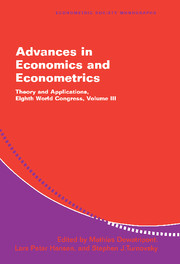Book contents
- Frontmatter
- Contents
- List of Contributors
- Preface
- 1 Contracting Constraints, Credit Markets, and Economic Development
- 2 Factor Models in Large Cross Sections of Time Series
- 3 Macroeconomic Forecasting Using Many Predictors
- “Big Data” Dynamic Factor Models for Macroeconomic Measurement and Forecasting: A Discussion of the Papers by Lucrezia Reichlin and by Mark W. Watson
- 4 How Severe Is the Time-Inconsistency Problem in Monetary Policy?
- 5 New Perspectives on Monetary Policy, Inflation, and the Business Cycle
- Comments on Papers by Stefania Albanesi, V. V. Chari, and Lawrence J. Christiano and by Jordi Galí
- 6 Consumption Smoothing and Extended Families
- 7 Computational Methods for Dynamic Equilibria with Heterogeneous Agents
- Index
2 - Factor Models in Large Cross Sections of Time Series
Published online by Cambridge University Press: 06 January 2010
- Frontmatter
- Contents
- List of Contributors
- Preface
- 1 Contracting Constraints, Credit Markets, and Economic Development
- 2 Factor Models in Large Cross Sections of Time Series
- 3 Macroeconomic Forecasting Using Many Predictors
- “Big Data” Dynamic Factor Models for Macroeconomic Measurement and Forecasting: A Discussion of the Papers by Lucrezia Reichlin and by Mark W. Watson
- 4 How Severe Is the Time-Inconsistency Problem in Monetary Policy?
- 5 New Perspectives on Monetary Policy, Inflation, and the Business Cycle
- Comments on Papers by Stefania Albanesi, V. V. Chari, and Lawrence J. Christiano and by Jordi Galí
- 6 Consumption Smoothing and Extended Families
- 7 Computational Methods for Dynamic Equilibria with Heterogeneous Agents
- Index
Summary
MOTIVATION
Business cycles are characterized by two features: comovements and regular phases of expansion and depression. Comovements are observed between aggregate variables – output and inflation, for example – and between disaggregates – individual consumption and regional output, for example. The time-series literature has typically analyzed these two characteristics in a separate way. Starting with the seminal contribution of Burns and Mitchell (1946), a huge amount has beenwrittenonthe “regularity” of cycles, asymmetries, and nonlinearities, on the basis of estimation of aggregate output or few relevant macroeconomic time series. A separate literature has addressed the issue of comovements, typically between few key aggregate time series and typically concentrating on long-run comovements (cointegration). Behind this literature, there is the implicit idea that the essential characteristics of the business cycle are captured by few relevant aggregate variables and that the information contained indisaggre gate time series or inall the potentially available aggregate time series is not particularly useful to understand macroeconomic behavior. This is also the implicit idea behind vector autoregression (VAR) modeling, where the propagation of “identified” aggregate shocks is analyzed in models typically containing a small number of variables.
In contrast, there is a large number of econometric studies that analyze the behavior of many consumers or many firms in order to understand the microeconomic mechanisms behind fluctuations. In these studies the cross section is typically large and the time-series dimension either absent or small. Economic theory is sufficiently heterogeneous so as not to give us clear guidance on what is the level of aggregation relevant for macroeconomic questions and on what is the appropriate stochastic dimension for macroeconomic models.
- Type
- Chapter
- Information
- Advances in Economics and EconometricsTheory and Applications, Eighth World Congress, pp. 47 - 86Publisher: Cambridge University PressPrint publication year: 2003
- 11
- Cited by



